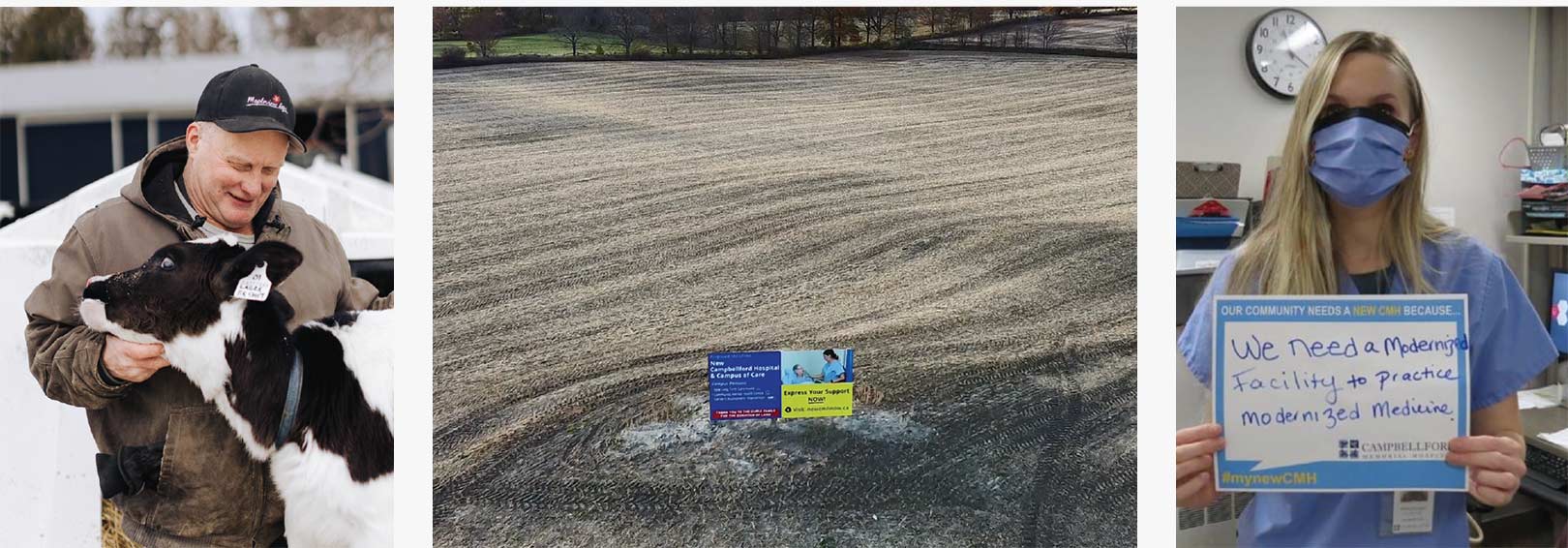
Jim Curle’s gift of land helps kick-start Campbellford’s dream of a new hospital, but there is still a long way to go, with no guarantees in sight
On a rainy morning last October, Campbellford dairy farmer Jim Curle stood in his soybean field and planted a new seed, one that he hopes will sprout for generations to come. Curle was there to announce that he was donating the land for the site of a new Campbellford Memorial Hospital and a long-term care facility.
Jim Curle’s family has farmed in the area for more than 150 years, but with no one stepping up to carry on, he has decided it’s time to scale back. Curle knew the hospital board was looking for land, so he donated his 48-acre field, which lies on the northwestern edge of town. Last year the fields were planted in soybeans, this spring he’ll plant corn, then barley and wheat, while waiting for a hospital to sprout. “I didn’t really want to see it developed into houses,” he says, explaining that he hopes the site will retain its open space and farmland feel.
But there is more to building a hospital than just real estate. Curle, along with the hospital’s CEO, board chair, and local politicians were also in his field that morning to pressure the provincial government to help make their dream come true.
AN AILING HOSPITAL
A new hospital for the Trent Hills area has been a dream for over a decade. Campbellford Memorial opened in 1953, but after several additions over the years, it is now a building of odds and ends that struggles to serve the healthcare needs of more than 40,000 people in its catchment area.
The frustration with the old building comes across loud and clear when talking to long-time staffers like Colleen Smith, manager of diagnostic imaging and a radiation technologist who has worked at the hospital for 20 years.
Smith notes that wheelchair accessibility is a major problem throughout the hospital – there is only one public washroom that is accessible. “Some of the patients’ rooms don’t have bathrooms in them, so the staff have to move them to another spot to use the bathroom,” she says. “And the doors aren’t wide enough to get some wheelchairs, or our beds through.”
Campbellford Memorial Hospital CEO Eric Hanna believes the health ministry does not appreciate the dire condition of the hospital.
Covid highlighted another major problem: None of the patient rooms have negative pressure, which helps keep any infections inside. This made it difficult to isolate any Covid cases and forced the hospital to shut down more often than would have been necessary in a newer building. Smith points out that the hospital recently passed its accreditation review but failed one section because of this issue.
A few years ago, the hospital had to close part of its operating room because the electrical system was not up to code and couldn’t safely handle some of the newer equipment that draws more power.
CRUNCHING THE NUMBERS
A health ministry study estimated it would cost at least $25 million to keep the facility open for another decade. So it’s not surprising that hospital administrators have felt for years that a new hospital should be built. But after about a decade of making polite requests to the powers that be, the people involved have decided their effort will only succeed if they focus on politics as well as health care.
They’re sending their message to Health Minister Sylvia Jones, who will decide which of the current 50 or more applications for new facilities around the province will go ahead. Their message is: “We are ready to do our share, but we need the ministry’s approval – and eventually about $150 million.”
The province pays 90 percent of the cost of a new building, and the local hospital foundation pays the full cost of equipping the new facility. It also has to obtain the land. This is what makes Jim Curle’s gift so timely. With rural farmland currently selling for bumper-crop prices, free land is a game changer. John Russell, executive director of the Campbellford Memorial Hospital Foundation, says the community plans to raise $25 million or more for the new facility, and he is confident they can hit that target over the five to seven years it will take to get the new hospital built.
FIRST STEPS
Kevin Huestis, chair of the hospital board, says there has been talk about a new hospital since he joined the board eight years ago, but things really moved ahead in the past year, after Eric Hanna became interim CEO.
In November 2021, Hanna, a retired hospital administrator who has experience getting a new hospital and long-term care facility built, stepped in. Hanna worked to ensure the application met all the requirements and started to talk openly about the dire state of the building and its equipment.
Hanna changed the board’s mindset, Huestis says. “I think there was an assumption in the community that we were going to get our new hospital and we just needed to be patient. And what I’ve come to realize is that there’s no guarantee here.”
Hanna says the publicity and numerous meetings with administrators and politicians have changed that outlook: “We are on their radar now, and we weren’t on their radar a year ago.”
Currently, the hospital board is seeking a $2.5 million planning grant so it can scope out the needs of the proposed new hospital and campus of care. Getting that grant is the first step in a five-stage process to final construction, and it comes with no guarantee of final approval.
Eric Hanna says health ministry officials have told him that “the decision to move to the next phase is an elected official decision.”
PASSING THE BUCKS
On February 2, David Piccini, MPP for Northumberland- Peterborough South, announced $13 million in funding for the existing hospital, including about $10 million to upgrade the facility. Piccini said the increased pressure on him has indeed helped get the new project noticed, but he also warned that inflation is cutting into infrastructure plans and could put new projects on hold.
Eric Hanna believes the health ministry does not appreciate the dire condition of the hospital. Colleen Smith sums up community opinion: “We don’t feel like it’s worth putting all this money into this building,” she says. “So that’s why we really need that approval for the new building.”
One thing that may push the hospital plan ahead is its partnership with OMNI Health Care, which hopes to construct a 128-bed long-term care facility. OMNI already has government approval to replace Burnbrae Gardens, but needs land. The Curle family’s gift has addressed that problem.
Huestis hopes that in 50 years the Curle family will look at their former fields and see a health care campus that embraces the environment while providing a full range of medical services. “It could have a rural feeling with apple orchards, lots of green space and walking trails.”
With a little luck and a lot more pushing, that vision could become reality.
Story by:
Art Chamberlain




